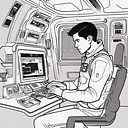Image datasets for developing ML algorithms
Introducing well-known Image datasets for developing machine learning algorithms
Image data refers to a collection of digital images that are stored and processed by computers. MNIST is a commonly used dataset for image classification tasks in machine learning and computer vision. It consists of 70,000 grayscale images of handwritten digits (0–9) and their corresponding labels. These images are pre-processed and normalized to 28x28 pixels and are used as input to train and test machine learning algorithms. MNIST is considered a benchmark dataset in the field and is widely used to evaluate the performance of various models.
Introduction
Image data is a type of data that represents visual information in the form of digital images. It is a collection of digital pixels that capture the color, texture, and shape of objects or scenes in a visual format. Image data can be generated by a digital camera, scanned from a physical photograph, or created using computer graphics.

The use of image data in machine learning and computer vision is widespread, and a variety of datasets are available for training and testing algorithms. One such dataset is the MNIST dataset, which stands for Modified National Institute of Standards and Technology. It is a database of handwritten digits, 0–9, that has become a benchmark for image classification tasks in the field of computer vision and machine learning.
Image data is an important aspect of machine learning and computer vision, and datasets play a crucial role in the development and evaluation of algorithms in these fields.
List of image datasets
There are many famous image datasets that are widely used in the field of computer vision and machine learning. Some of these datasets are:
- MNIST: As mentioned earlier, it is a simple dataset consisting of grayscale images of handwritten digits, 0–9, and is often used as a benchmark for evaluating the performance of machine learning algorithms.
- CIFAR-10 and CIFAR-100: These are datasets of small color images in 10 and 100 classes, respectively. They are often used as a benchmark for evaluating the performance of computer vision algorithms and are considered to be slightly more challenging than MNIST.
- ImageNet: This is a large-scale dataset of over 1 million images, organized into over 20,000 categories. It is widely used in the field of computer vision for evaluating the performance of deep learning algorithms on various computer vision tasks.
- PASCAL VOC: This is a dataset of images and annotations for various computer vision tasks, including object detection, segmentation, and classification.
- Caltech-101: This is a dataset of images of objects belonging to 101 categories, including animals, vehicles, and everyday objects.
Sorting these datasets based on training complexity, from the easiest to the most challenging:
- MNIST
- CIFAR-10 and CIFAR-100
- Caltech-101
- PASCAL VOC
- ImageNet
It’s important to note that the training complexity of these datasets depends on the algorithms used and the hardware and infrastructure available. The difficulty of these datasets may also vary depending on the specific task, such as object detection, classification, or segmentation.
Conclusion
Image datasets play a crucial role in the development and evaluation of algorithms in the field of computer vision and machine learning. There are many famous image datasets available, ranging from simple datasets like MNIST to large-scale datasets like ImageNet. The choice of dataset depends on the specific task and the complexity of the problem. MNIST is a simple dataset that is often used as a benchmark for evaluating the performance of machine learning algorithms, while ImageNet is a larger and more complex dataset that is used to evaluate the performance of deep learning algorithms on various computer vision tasks. Understanding the available image datasets and their characteristics is important for effectively utilizing them in the development and evaluation of algorithms in the field of computer vision and machine learning.
